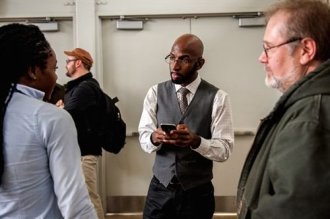In the wake of Donald Trump’s 2016 victory, a progressive group called the Justice Democrats jumped into action. If the liberal establishment had failed to keep Trump from power, clearly it was time for some fresh political blood. The group embarked on a hunt for potential candidates, putting out a nationwide call for nominations of community leaders who might make good members of Congress.
The following year, Justice Democrats invited a few standouts among those nominees to “The Candidate Summit,” a gathering in Frankfort, Kentucky. You’ve already heard a lot about one of them: Alexandria Ocasio-Cortez — now a freshman Congresswoman, social media maven, and pied piper for American progressives.
But you probably have not heard about another one of the people there: 35-year-old grassroots organizer Demond Drummer, who was at the time cofounder of a group that teaches computer science to kids on Chicago’s South Side. At that summit, Drummer realized that running for office wasn’t for him, at least for the time being. Instead, it sparked another idea: Creating a new progressive think tank that would explore how to jumpstart a more equitable society.
That thought remained preliminary until the summer of 2018, when Drummer attended the Aspen Ideas Festival in Colorado. He sat through the talks, but he wasn’t hearing about ideas that could begin to address the problems we face in this country. He had a realization: The people who are in power have no clue what has to happen next. That was his aha moment, he said. He went from being interested in starting up an organization to thinking, “this is the goal of my life.”
He wondered: What are the ideas that might fix the economy and heal the planet? Would it be possible to build an organization that could come up with a solution to the “climate crisis, the economic crisis, and the global crisis, which is rooted in the history of systematic injustice,” as he put it, all at the same time?
“That really got me interested in jumping in on this idea of building an organization,” he said. “That was the idea of New Consensus.”
Later that year, he started putting the concept into action. Drummer’s notion, from the start, was that the U.S. didn’t merely need to solve climate change. It needed an economic transformation, a re-envisioning and rethinking that would make it possible to put a sustainable future on solid ground.
He wasn’t the only one thinking this way — variations of this concept had been kicking around for several years, under the general rubric of a Green New Deal.
In the past five months, the Green New Deal has received reams of media attention. The hubbub is largely focused on Representative Ocasio-Cortez, who — with the help of a vocal cadre of young people affiliated with the activist group Sunrise Movement — popularized the idea.

Before starting the progressive think tank New Consensus, Demond Drummer taught computer science to kids in Chicago’s South Side. Justice Democrats
In February, she, along with Massachusetts Senator Ed Markey, introduced a non-binding resolution laying out the proposal’s goals. It whipped Washington into a frenzy. Democratic Senators vying for the 2020 presidential nomination lined up to cosponsor it, and parties on the right have been equally eager to skewer it.
As Ocasio-Cortez stoked the flames of public support for such a plan, Drummer realized the Green New Deal was the “best tangible, concrete expression of the kind of economics and politics that we were fighting for and trying to develop.”
All that noise and heat have obscured precisely what the Green New Deal is — the deeper ideas that motivate it, and the people who are getting it off the ground. Is it simply a climate plan with a progressive wish list tacked on, as most have described it? Or is it something far more powerful — a bid to shatter a calcified political establishment and take the economy in a new direction?
Building the team
At the same time that Drummer was hatching his plan, Rhiana Gunn-Wright, a Rhodes Scholar and former intern for Michelle Obama, was working as policy director for progressive Michigan gubernatorial candidate Abdul El-Sayed. She was developing forward-thinking ideas such as MichCare, a state-level single-payer healthcare plan, but the candidate’s bid for a new vision for Michigan failed. He lost to a more moderate candidate last fall.
Gunn-Wright was moving on, preparing to apply for law school, when Drummer approached her. He’d heard about her work for El-Sayed — her 11 policy proposals and 250 pages of policy documents — and wanted her to join his team. “Her reputation preceded her,” he said. She took him up on the offer.
Gunn-Wright and Drummer are now the core of New Consensus — “a policy shop that moves like an organizing shop,” as Drummer puts it — which is growing, but still only has a handful of employees. They have a formidable task in front of them: In less than a year, craft a nation-changing set of policies that can refocus the economy toward justice and sustainability. The timeline is so short because by March 2020 at the latest, Ocasio-Cortez plans to introduce draft Green New Deal legislation in the House. If 10 months later, the Democrats gain control of the House, Senate, and Presidency — possible if unlikely, according to political pundits — portions of the Deal might have a shot at becoming law.
To be sure, New Consensus isn’t alone on this mission. Other players include the Sunrise Movement, the Justice Democrats (which counts Drummer as a board member), and, of course, Ocasio-Cortez’s office. But Drummer and his team, are, in his words, “playing quarterback” in translating its ideas into action.
More than just green
While the Green New Deal has been primarily described in the press as a climate plan, Gunn-Wright and Drummer see it as a triangle, with justice, the economy, and climate action each forming a side. It’s a different way of thinking about sustainability — one that emerges in part from the fact that neither Drummer nor Gunn-Wright are steeped in the traditional environmental movement.
“That’s probably a very good thing,” Drummer told Grist. So-called “Big Green” — the major national environmental organizations and other non-profits traditionally associated with the movement — has a track record of prioritizing aims like conservation over projects that would help marginalized communities that often bear disproportionate burdens of the fossil fuel-based economy.

Rhiana Gunn-Wright joined New Consensus after serving as policy director for progressive Abdul El-Sayed’s unsuccessful run for Michigan governor. Eric Taylor
As Drummer and Gunn-Wright see it, that’s not good enough. It’s not enough to move toward a stratified economy where only the wealthy can drive electric cars, live in homes powered by renewable energy, breathe clean air, and drink clean water. “That dog ain’t gonna hunt,” said Drummer, who is originally from Texas. “What we want is a zero waste, zero carbon, zero poverty economy.”
All too often, said Gunn-Wright (a 2019 Grist 50 honoree), policies are divorced from people’s lived realities. “Then the onus ends up on the communities that are hurt, that usually have less social capital, less political capital, less time to take to the streets, to organize to get that policy reconsidered,” she explained. As policy lead for New Consensus, she wants to flip that script on its head, and consult with marginalized communities first.
At its core, New Consensus shares some priorities with the environmental justice movement, which emphasizes equity in climate and environmental solutions. “The EJ movement clarifies how issues of climate change actually are directly related to issues of social justice, racial justice, economic justice,” Drummer said.
So in its version of the Green New Deal, New Consensus will fold in non-climate objectives like universal healthcare, a federal jobs guarantee, and a transition to renewable energy sources that gives fossil fuel workers a role in a high-growth, clean-energy economy.
“Their role is crucial in seeing a Green New Deal that is going to not just address climate change but also rising inequality,” said Alexandra Rojas, executive director of Justice Democrats.
A public/private partnership
The economy envisioned by New Consensus looks very different from the one we have now: In this version of the future, Americans will be employed in well-paying green industries, covered by universal insurance, and given the training they need to make the transition to a sustainable economy.
According to Drummer, the public and private sectors must work together if the U.S. is to get to this point — and do its part in helping the world avert climate catastrophe. In his view, both political parties have operated in recent decades under an economic model that gives the private sector too much power. The result: the disenfranchisement of workers and the erosion of the middle class.
As a model for its Green New Deal legislation, New Consensus is studying how federal policy sparked the manufacturing sector during World War II. But this time, instead of an all-out effort to win a war, the economy will be retooled around the renewable energy sector. “Wouldn’t it be great if we could mobilize around something that’s not war?” asked Drummer.
We also shouldn’t be afraid to look to the past for inspiration in developing the kind of federal policies that encouraged domestic manufacturing during the second half of the 20th century, Drummer said. The New Consensus vision relies on the premise that the public sector can help finance the transition to a green economy.
For instance, the U.S. steel industry provides one example of how the public and private sectors could team up to boost domestic manufacturing and simultaneously promote sustainability. If the goal is to build greener steel domestically, add new jobs, and stop importing dirty steel from China, there’s a problem, Drummer said: “The technology to do that is extremely expensive, and it doesn’t make sense that private companies are expected to do it by themselves.”
That’s where federal investment comes into play — in this instance, by incentivizing domestic production. “Public investment in research, development, and crucially, deployment, can jumpstart the decarbonization of the American steel industry — even while the technology continues to be optimized,” Drummer said.
In order for the Green New Deal to take shape, dozens more policies like this one must be developed, in addition to ones that could bring other progressive shifts related to health care and jobs.

Representative Alexandria Ocasio-Cortez and Senator Ed Markey (right) hold a news conference to unveil their Green New Deal resolution in early February, as members of the youth climate action group Sunrise Movement look on. Alex Wong / Getty Images
That broad reach isn’t necessarily a weakness, suggested Brandon Hurlburt, a New Consensus advisor who served as chief of staff to Nobel laureate Stephen Chu, secretary of energy under President Obama. “One of the reasons the New Deal framework works is because it isn’t just one piece of legislation.” Similarly, this Green New Deal “will need to happen likely over a few pieces of legislation over several years.”
The price is right
Big visions come with big price tags, and the cost of implementing a plan as comprehensive as the Green New Deal is daunting. Multiple estimates peg the transition to clean energy alone at more than $10 trillion, and other policies that Drummer and Gunn-Wright are proposing would add billions or even trillions to the ledger.
But in their view, it’s not a liability to tie climate action to other big-ticket items like a new industrial policy, or even universal health care or a federal jobs guarantee. After all, if you’re going to pivot to a different kind of economy, those “progressive wish list” items are critical to ensuring the health and dignity of those who might suffer as the U.S. undergoes the massive disruptions necessary to secure a more sustainable future.
By connecting climate action to more tangible issues like wages and health care, New Consensus also hopes to create a national strategy that everyone can get behind — and benefit from. Try explaining the importance of installing more solar panels to a single mother who can’t get childcare, Gunn-Wright said. Illuminating the connection between quality of life and climate action is how they’ll get everyone on board.
“For so long, we have talked about the climate in an abstract, global way — we talk about a reduction in emissions or we talk about keeping the global temperature from rising a particular number of degrees,” she said. “The way that climate change affects people is on a personal level.”
Besides, as Drummer pointed out, it’s not like the U.S. hasn’t spent billions upon billions of dollars on averting the complete collapse of our society in the past. He pointed to the $700 billion Troubled Asset Relief Program passed in 2008 to rescue the American economy. Then he unfurled a quip that would serve him well if he ever does decide to run for Congress: “The same creativity that we used to bail bankers out of that collapse can be applied to finance our future and save the planet.”

